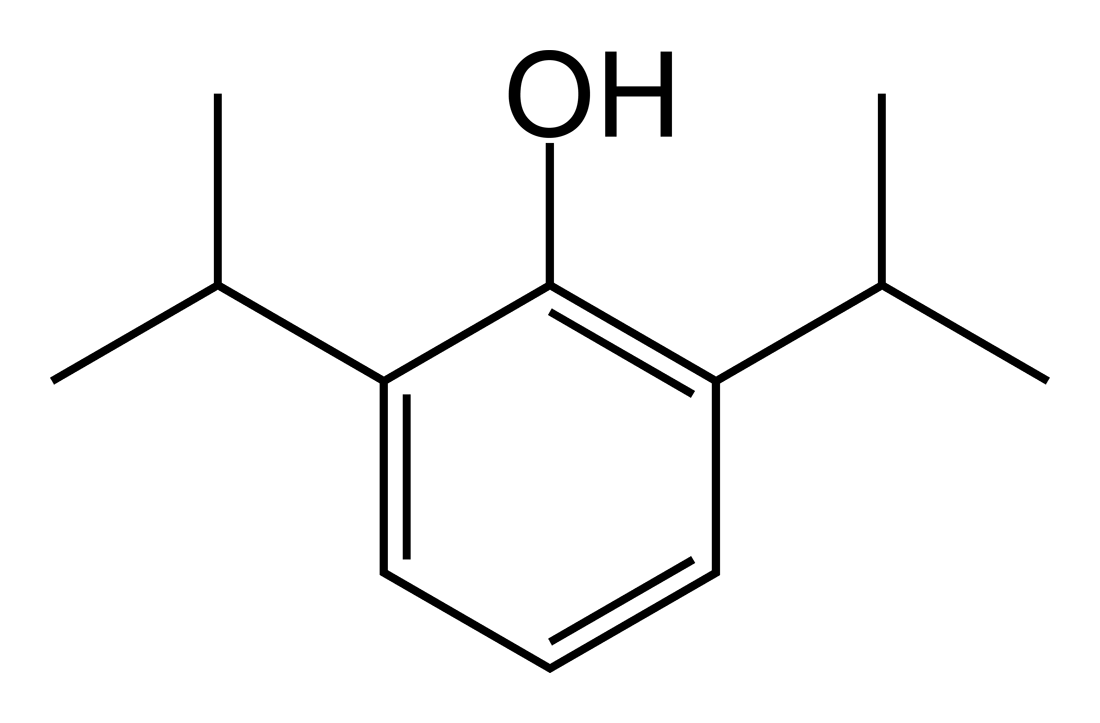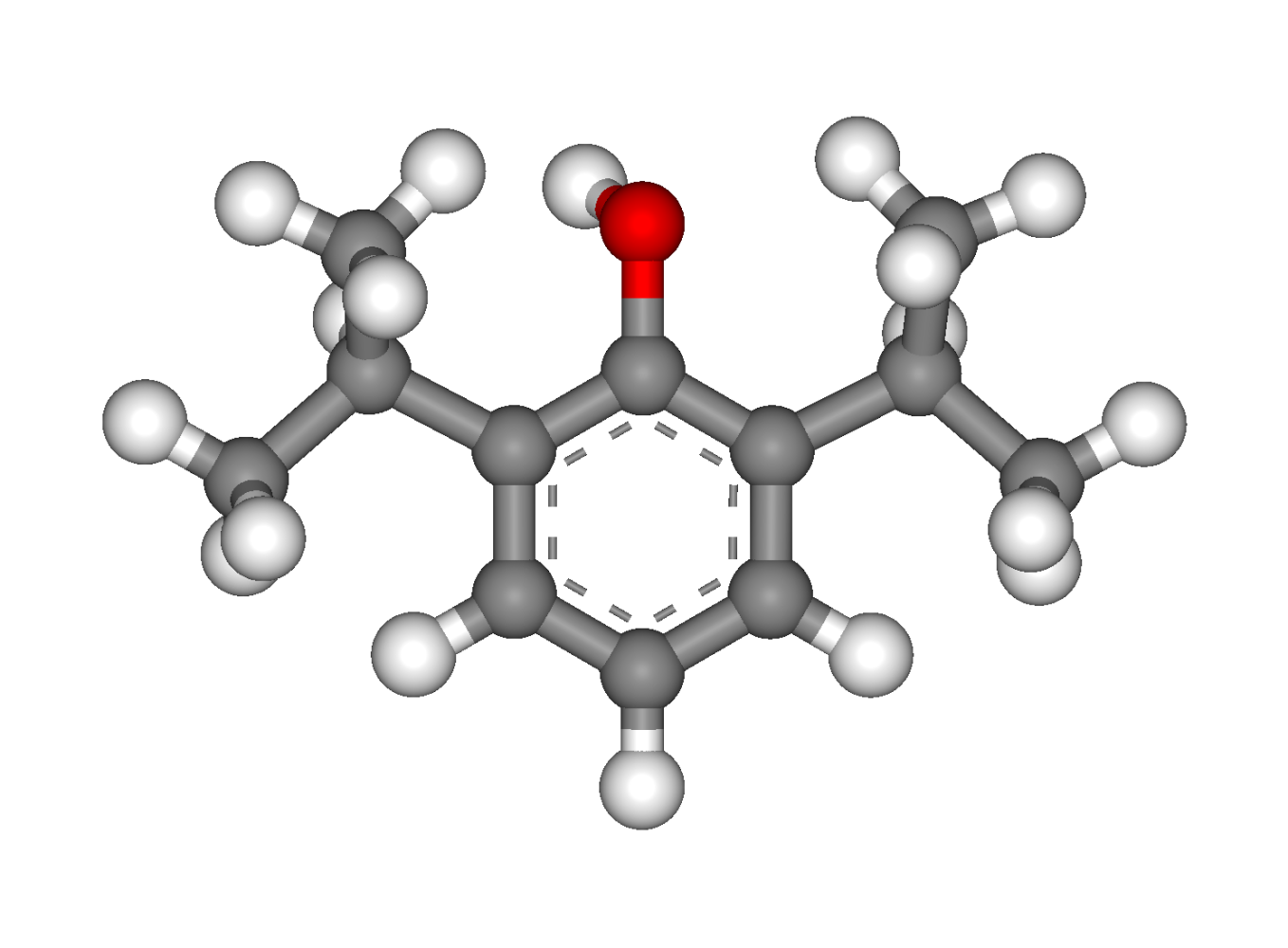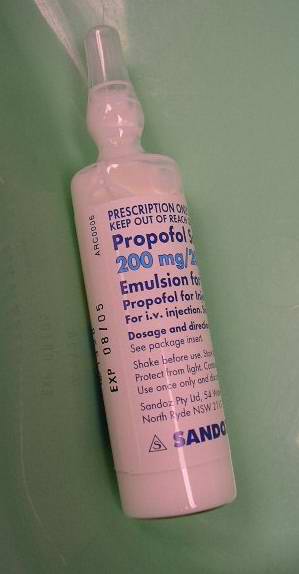Propofol: Difference between revisions
No edit summary |
|||
| Line 52: | Line 52: | ||
Another recently described rare, but serious, side effect is ''propofol infusion syndrome''. This potentially lethal metabolic derangement has been reported in critically-ill patients after a prolonged infusion of high-dose propofol in combination with [[catecholamine]]s and/or [[corticosteroid]]s.<ref>{{cite journal |author=Vasile B, Rasulo F, Candiani A, Latronico N |title=The pathophysiology of propofol infusion syndrome: a simple name for a complex syndrome |journal=Intensive care medicine |volume=29 |issue=9 |pages=1417-25 |year=2003 |pmid=12904852 |doi=10.1007/s00134-003-1905-x}}</ref> | Another recently described rare, but serious, side effect is ''propofol infusion syndrome''. This potentially lethal metabolic derangement has been reported in critically-ill patients after a prolonged infusion of high-dose propofol in combination with [[catecholamine]]s and/or [[corticosteroid]]s.<ref>{{cite journal |author=Vasile B, Rasulo F, Candiani A, Latronico N |title=The pathophysiology of propofol infusion syndrome: a simple name for a complex syndrome |journal=Intensive care medicine |volume=29 |issue=9 |pages=1417-25 |year=2003 |pmid=12904852 |doi=10.1007/s00134-003-1905-x}}</ref> | ||
Abuse of propofol as a recreational drug has been reported, usually by medical staff such as anaesthesiologists who have access to the drug. Despite a lack of analgesic properties, propofol's sedative action presumably produces euphoric effects. The steep dose response curve of the drug makes such abuse very dangerous without proper monitoring, and several deaths have been recorded.<ref>Iwersen-Bergmann S, Rösner P, Kühnau HC, Junge M, Schmoldt A. Death after excessive propofol abuse. International Journal of Legal Medicine. 2001;114(4-5):248-51.</ref><ref>Kranioti EF, Mavroforou A, Mylonakis P, Michalodimitrakis M. Lethal self administration of propofol (Diprivan). A case report and review of the literature. Forensic Science International. 2007 Mar 22;167(1):56-8. Epub 2006 Jan 23.</ref> | Abuse of propofol as a recreational drug has been reported, usually by medical staff such as anaesthesiologists who have access to the drug. Despite a lack of analgesic properties, propofol's sedative action presumably produces euphoric effects. The steep dose response curve of the drug makes such abuse very dangerous without proper monitoring, and several deaths have been recorded.<ref>Iwersen-Bergmann S, Rösner P, Kühnau HC, Junge M, Schmoldt A. Death after excessive propofol abuse. International Journal of Legal Medicine. 2001;114(4-5):248-51.</ref><ref>Kranioti EF, Mavroforou A, Mylonakis P, Michalodimitrakis M. Lethal self administration of propofol (Diprivan). A case report and review of the literature. Forensic Science International. 2007 Mar 22;167(1):56-8. Epub 2006 Jan 23.</ref> It has been rumored and not verifed that Michael Jackson was injected with propophol. | ||
==References== | ==References== | ||
Revision as of 12:38, 1 July 2009
 | |
 | |
| Clinical data | |
|---|---|
| Pregnancy category | |
| Routes of administration | Intravenous |
| ATC code | |
| Legal status | |
| Legal status |
|
| Pharmacokinetic data | |
| Bioavailability | NA |
| Protein binding | 95 to 99% |
| Metabolism | Hepatic glucuronidation |
| Elimination half-life | 30 to 60 min |
| Excretion | Renal |
| Identifiers | |
| |
| CAS Number | |
| PubChem CID | |
| DrugBank | |
| E number | {{#property:P628}} |
| ECHA InfoCard | {{#property:P2566}}Lua error in Module:EditAtWikidata at line 36: attempt to index field 'wikibase' (a nil value). |
| Chemical and physical data | |
| Formula | C12H18O |
| Molar mass | 178.271 g/mol |
|
WikiDoc Resources for Propofol |
|
Articles |
|---|
|
Most recent articles on Propofol |
|
Media |
|
Evidence Based Medicine |
|
Clinical Trials |
|
Ongoing Trials on Propofol at Clinical Trials.gov Clinical Trials on Propofol at Google
|
|
Guidelines / Policies / Govt |
|
US National Guidelines Clearinghouse on Propofol
|
|
Books |
|
News |
|
Commentary |
|
Definitions |
|
Patient Resources / Community |
|
Directions to Hospitals Treating Propofol Risk calculators and risk factors for Propofol
|
|
Healthcare Provider Resources |
|
Causes & Risk Factors for Propofol |
|
Continuing Medical Education (CME) |
|
International |
|
|
|
Business |
|
Experimental / Informatics |
Please Take Over This Page and Apply to be Editor-In-Chief for this topic: There can be one or more than one Editor-In-Chief. You may also apply to be an Associate Editor-In-Chief of one of the subtopics below. Please mail us [1] to indicate your interest in serving either as an Editor-In-Chief of the entire topic or as an Associate Editor-In-Chief for a subtopic. Please be sure to attach your CV and or biographical sketch.
Propofol is a short-acting intravenous anesthetic agent used for the induction of general anesthesia in adult patients and pediatric patients older than 3 years of age; maintenance of general anesthesia in adult patients and pediatric patients older than 2 months of age; and sedation in medical contexts, such as intensive care unit (ICU) sedation for intubated, mechanically ventilated adults, and in procedures such as colonoscopy. It provides no analgesia.[1]
Propofol is approved for the induction and maintenance of anesthesia in more than 50 countries.
It is also commonly used in veterinary medicine and many veterinary anaesthetists regard it as the induction agent of choice for small animals (dogs, cats etc) as it can be administered to effect, reducing the risk of accidental overdose.
Chemistry

Propofol is a water-immiscible oil and so cannot be injected per se. Originally developed by ICI (Imperial Chemical Industries) as ICI 35868, initial clinical trials followed in 1977 in a form solubilised in cremophor EL. However, due to anaphylactic reactions it was withdrawn from the market and subsequently reformulated as an emulsion of a soya oil/propofol mixture in water. This was re-launched in 1986 by AstraZeneca with the brand name Diprivan (shortened version of DI-isoPRopyl IV ANesthetic). The current preparation is 1% propofol, 10% soybean oil and 1.2% purified egg phospholipid (emulsifier), with 2.25% of glycerol as a tonicity adjusting agent, and sodium hydroxide to adjust the pH. Diprivan contains EDTA as an antimicrobial agent. Newer generic formulations contain sodium metabisulfite or benzyl alcohol. Propofol emulsion appears as a highly opaque white fluid due to the scattering of light from the tiny (~150 nm) oil droplets that it contains.
A water soluble form of the drug, propofol phosphate, has recently been developed and tested in animals with positive results, being rapidly broken down once in the body to form propofol. This new formulation might well have superior properties for use in humans such as being more readily injectable and perhaps without the pain at injection site that often occurs with the traditional form of the drug.[2] Fospropofol disodium is rapidly converted into propofol by the enzyme alkaline phosphatase, and is now being developed for human use under the brand name Aquavan.[2]
Pharmacology
Propofol is highly protein bound in vivo and is metabolised by conjugation in the liver. Its rate of clearance exceeds hepatic blood flow, suggesting an extrahepatic site of elimination as well. Its mechanism of action is uncertain, but it is postulated that its primary effect may be potentiation of the GABA-A receptor, possibly by slowing the channel closing time. Recent research has also suggested the endocannabinoid system may contribute significantly to Propofol's anesthetic action and to its unique properties.[3]
The elimination half-life of propofol has been estimated to be between 2–24 hours. However, its duration of clinical effect is much shorter because propofol is rapidly distributed into peripheral tissues, and its effects therefore wear off considerably within even a half hour of injection. This, together with its rapid effect (within minutes of injection) and the moderate amnesia it induces makes it an ideal drug for IV sedation.
Side effects
Aside from the hypotension (mainly through vasodilatation) and transient apnea following induction doses, one of propofol's most frequent side effects is pain on injection, especially in smaller veins. This pain can be mitigated by pretreatment with lidocaine.[4] Patients tend to show great variability in their response to propofol, at times showing profound sedation with small doses. A more serious but rare side effect is dystonia. Mild myoclonic movements are not uncommon, as with other intravenous hypnotic agents. Propofol appears to be safe for use in porphyria, and has not been known to trigger malignant hyperpyrexia.
Another recently described rare, but serious, side effect is propofol infusion syndrome. This potentially lethal metabolic derangement has been reported in critically-ill patients after a prolonged infusion of high-dose propofol in combination with catecholamines and/or corticosteroids.[5]
Abuse of propofol as a recreational drug has been reported, usually by medical staff such as anaesthesiologists who have access to the drug. Despite a lack of analgesic properties, propofol's sedative action presumably produces euphoric effects. The steep dose response curve of the drug makes such abuse very dangerous without proper monitoring, and several deaths have been recorded.[6][7] It has been rumored and not verifed that Michael Jackson was injected with propophol.
References
- ↑ Miner JR, Burton JH. Clinical practice advisory: Emergency department procedural sedation with propofol. Annals of Emergency Medicine. 2007 Aug;50(2):182-7, 187.e1. Epub 2007 Feb 23.
- ↑ Banaszczyk MG, Carlo AT, Millan V, Lindsey A, Moss R, Carlo DJ, Hendler SS. Propofol phosphate, a water-soluble propofol prodrug: in vivo evaluation. Anesthesia and Analgesia. 2002 Nov;95(5):1285-92
- ↑ Fowler, CJ. "Possible involvement of the endocannabinoid system in the actions of three clinically used drugs." Trends Pharmacol. Sci. 2004 Feb;25(2):59-61.
- ↑ "Propofol Drug Information,Professional". drugs.com. Retrieved 2007-01-02. External link in
|publisher=(help) - ↑ Vasile B, Rasulo F, Candiani A, Latronico N (2003). "The pathophysiology of propofol infusion syndrome: a simple name for a complex syndrome". Intensive care medicine. 29 (9): 1417–25. doi:10.1007/s00134-003-1905-x. PMID 12904852.
- ↑ Iwersen-Bergmann S, Rösner P, Kühnau HC, Junge M, Schmoldt A. Death after excessive propofol abuse. International Journal of Legal Medicine. 2001;114(4-5):248-51.
- ↑ Kranioti EF, Mavroforou A, Mylonakis P, Michalodimitrakis M. Lethal self administration of propofol (Diprivan). A case report and review of the literature. Forensic Science International. 2007 Mar 22;167(1):56-8. Epub 2006 Jan 23.
External links
Template:General anesthetics Template:Sedative
- Pages with script errors
- CS1 errors: external links
- CS1 maint: Multiple names: authors list
- Drugs with non-standard legal status
- E number from Wikidata
- ECHA InfoCard ID from Wikidata
- Articles without EBI source
- Chemical pages without ChemSpiderID
- Articles without KEGG source
- Articles without InChI source
- Articles without UNII source
- Articles containing unverified chemical infoboxes
- Anesthetics
- Phenols